(**UPDATE: There has since been a Suunto 7 In-Depth Review. Follow the link for the most up to date information**)
There’s only two words to describe the just announced Suunto 7 GPS watch: Hail Mary.
How this story ends will take a few years to flesh out, but just as most Hail Mary attempts, it only ends in one of two ways: Astounding success or utter failure. It’s no secret that Suunto has struggled to compete lately, primarily in the last two years. They’ve been sandwiched out by two ends: Garmin in the endurance sports realm, and Apple in the higher-end smartwatch realm. Plus of course plenty of other competitors. But Garmin and Apple are actually the two that hurt Suunto the most.
The Suunto 7 attempts to disturb that trend by jumping on the Wear OS bandwagon, but with a decidedly Suunto and sports-focused twist. This move allows them instant access to everything from full onboard maps and routing, to music streaming services, and even contactless payments. Plus of course the bulk of their existing sports functions and heritage. It’s a risky bet that just a few months ago would have been considered destined for failure – mainly due to the heavy battery life limitations of Wear OS (it’ll last barely over a day).
But one massive factor changes that trajectory: Google’s acquisition of Fitbit.
The company made clear in their announcement that they planned to double-down on Wear OS, with it becoming the future of Fitbit devices. Those being devices that, by definition, consumers expect to last upwards of a week or more on a single charge – not terribly unlike expectations of today’s Suunto watches. The challenge though is simple: Wear OS battery life isn’t there yet today – and despite years of talk, there’s no proof that’s coming anytime in the immediate future. But that momentum may give Suunto just enough time to build out their Wear OS watches while the greater electronics industry sorts out the limitations.
Now, if you wanna dive right into things, simply hit the play button below. I go over all the specs, and then do a full hands-on walk-through of the user interface. Plus a few tidbits from my first run as well.

For now, let’s talk tech specs.
The Tech Specs:
The Suunto 7 is kinda the blend of a Suunto 5 watch with that of a typical Wear OS device. Except for all the things that are different – and there are a ton of them different. If you’re a triathlete that has a Suunto 9 and is looking for a fancier experience – this won’t be for you. At least not today. But, if you’re more of a Wear OS person that wants deeper sports bits, this could definitely be for you. Or if you’ve been flirting with an Apple Watch, this could be for you too.
One super quick thing to get out of the way: iOS and Android phones can both connect just fine to Wear OS devices. There are some limitations that we’ll get into, but for the bulk of features, you don’t need an Android phone or anything. This isn’t like an Apple Watch that *only* pairs to Apple iOS devices.
With that, let’s talk top-line hardware specs first:
Price/Availability: $499 shipping January 31st, 2020
Display: 1.39” full color AMOLED Display (454px across, circular), 1000 nits in boost, 300n otherwise
Battery life: Up to 2 days smartwatch, up to 12 hours GPS, up to 8 hours with music playback, up to 40 days in time-only mode
Weight: 70g, stainless steel bezel & silicon strap
Waterproofing: 50m
GPS Connectivity: GPS/GLONASS/GALILEO/QZSS/Beidou
Phone Connectivity: Android or iOS
Music Storage: 8GB
Buttons: Four physical buttons + touchscreen
Sensor connectivity: No
Altimeter: Barometric enabled altimeter
Headphone Connectivity: Any Bluetooth music device (headphones/car/etc…)
Optical HR Sensor: Yes, sensor from Pixart and algorithm from LifeQ
Cellular Connectivity: No cellular hardware inside the watch
Microphone: Yes, but no audio speaker (have to use headphones)
Vibrations/Beeper: Yes to both, simplistic beeper
Payments: NFC via Google Pay
Note that for a Wear OS device, a claim of 2-days (technically it’s listed as 48hours), would be a moderate milestone. Most Wear OS devices claim 2 days, but rarely hit it. The Suunto 7 is leveraging the Qualcomm SnapDragon 3100 processor, which may help in that realm. But again, the proof is in the pudding. Also, there’s a bunch of different colors, but they’re all the same price/weight/underlying materials:
Next, there’s the software and features side of the house:
– Has true 24×7 heart rate monitoring, feed into the Google Fit app
– Supports 70+ sport modes, essentially the same ones as Suunto already has but w/o sensor support
– No triathlon/multisport mode support (yes OWS)
– Ability to see heatmaps directly on the watch itself (and way more visible than Garmin’s Fenix 6 ones)
– Ability to create routes on phone app to send to watch (but breadcrumb only, no turn by turn routing with street names or such)
– Music integration via Google Play music as well as 3rd party Wear OS apps
– Support for all Wear OS Apps
– Wear OS version H-MR1
– Daily 24×7 activity tracking feeds into Google Fit, not the Suunto App initially (workouts go to Suunto App)
– Plus all the usual Wear OS features like telephone call answering via phone, weather, ‘Hey Google’, and so on.
Ok, so there’s your quick round-up of specs. As you can see, it’s mostly a WearOS device that Suunto has added their specific sport tracking apps too. In other words, they re-wrote their entire sport tracking engine and placed it atop WearOS. Whereas the underlying activity features (like steps/24×7 HR/etc…) will instead leverage the Wear OS platform initially. It’s a tricky split that we’ll get into later on, but does allow them to get started on the core features that people want now, and fill in the ancillary bits over time.
Hands-On:
First off, if you come back sometime tomorrow, you’ll find this section entirely gutted and refreshed with way better outdoor photos and more details. But today’s the start of CES in Las Vegas and by the time I landed it was dark out, and sport watches always film horribly indoors in poor ballroom lighting where tonight’s event is being held. I also tried outdoors at night, and they sucked equally. I hate poor pictures, so come back tomorrow for pretty pics. Until then, this will whet your appetite.
The first thing you’re going to notice is the watch face – because quite frankly is the coolest watch face I’ve come across, sport watch or otherwise. It is changeable, but the default (and again, coolest face ever) is an activity heatmap based on your current area/GPS location. In my case, I had just updated the watch software, so it hadn’t yet refreshed the map tiles as well for my new location. It will pull this location via either GPS on the device itself, or simply via your phone. Further, you can set the specific preferred zoom level too, from four different settings.
But it gets even cooler than that. You can actually customize the type of heatmap, including which sport heat you want to show. For better or worse, there are no heat maps of hot yoga.
But it gets even cooler – you can also change the zoom level of the heat map watch face:
Now, the way the Suunto 7 works is by basically thinking of it as two watches in one. You’ve got the Wear OS foundation that has the operating system and all the Google-ish things like notifications, calendars, 24×7 activity tracking, etc… For example, swipe from the left and you’ll see the usual Wear OS bits:
Swipe from the bottom and you’ve got smartphone notifications:
And swipe from the top and you’ve got settings:
And then you’ve got the workout-specific piece that falls into an app Suunto has developed for Wear OS that essentially mirrors much of the Suunto sport interface on any other Suunto watch.
If you’re familiar with Suunto watches, then the border wall is super simple: When you press the upper right button to select a sport mode, that’s effectively starting the Suunto Wear OS app. Almost everything else is handled by Wear OS natively. So, once we press that upper right button, we get to choose which sport we want:
The sport options here are the roughly 70 or so sport modes that Suunto has on other watches, except that you won’t find triathlon or multisport in the list (but openwater swimming is in there).
Below that, you’ll be able to change a handful of options. For example, the ‘exercise options’ menu tweaks tones/vibrations/screen display (including setting ‘always-on for workouts), while the ‘map options’ menu allows you to change the map style between Outdoor or Winter, as well as all the heat map variants.
It also allows you to define a 70KM square area to download (44mi). At this point you can only download one square at once, however, it will background download on the fly if connectivity is available for areas as you move into them.
Back in the sport settings, you’ll see the heart rate sensor status as well as GPS lock. From there, you’ll simply swipe the start button to get started with your workout:
At which point you’ll be in a workout data page mode. You can swipe through the different data pages (or press the middle button). These include a lap page, a map page, heart rate/distance/pace-speed/time, and heart rate zones. However, none of these – nor any other pages are customizable. At this point there isn’t a plan on if or when they’ll be customizable. It sounds like they’re looking at that as an option, but it’s not there today nor on any specific plan.
Here’s a quick look at the three data pages during my run this morning:
The responsiveness though is very good – certainly faster than a Suunto 9 side by side, plus, these are pretty color versus the Suunto 9 is a wee bit more dull. Like most watches, the brightness level of the watch will vary based on conditions.
And a daylight picture:
Typically speaking though the display will hover up to about 300 nits, however it can burst up to 1,000 nits for short periods of time.
You can create manual laps at any time by pressing the lower right button, or you can pause by pressing the upper right button. From there it’ll pause the recording and show you current battery status, as well as allow you to review your stats as-is, without actually ending the session.
Once you decide to end it, you’ll get a pretty familiar Suunto completion screen.
Of note is that within that screen you’ll see metrics like Recovery Time, EPOC, and PTE. However, unlike other Suunto watches – there are no aspects of the Suunto 7 that use FirstBeat metrics. Instead, the company is doing it all internally.
Oh, and before we leave the workout bits entirely – the Suunto 7 supports breadcrumb trail routes sent to it from the Suunto smartphone app. So if you’ve got a route there, you’ll be able to send it to the Suunto 7 watch to guide you. But it doesn’t do turn by turn type routing, nor can you create a route from the watch itself (though, I need to figure out how precisely to do that still…).
On the bright side, the maps are brilliantly fast, and are approximately 1 million times better than Garmin’s heatmap implementation. I can zoom in/out as far as I darn well want and still get heatmaps instantly, and ones that are actually super practical to use.
So about that heart rate sensor – that’s a big shift. The company has ditched Valencell’s package and gone with a combo-dish from LifeQ’s algorithms and a sensor from PixArt. LifeQ may actually ring a bell – as back about five years ago we saw TomTom employ them for their optical HR sensors in some of their wearables. It wasn’t all bad at the time, but LifeQ doesn’t list many partners since then on their site (nor much recent info at all on their site) as to other examples of who might be using more recent sensor packages. Note you’ll see Garmin listed, but that’s purely some backend corporate health wellness initiative stuff from four years ago and Garmin confirmed then it had zero to do with sensors or wearable/consumer tech.
In any case, Suunto’s HR sensor change doesn’t terribly surprise me. While Valencell has historically had great sports-focused accuracy, collectively both Suunto and Valencell have really struggled to deliver accuracy in the Suunto 3/5/9 products, based on my testing. I suspect on the heavier products that’s a major contributor (as both companies have admitted, as weight introduces bounce, which challenges optical HR sensors). But that doesn’t explain the issues with the far lighter products. Add atop that the lack of true 24×7 optical HR recording for any meaningful length of time battery-wise, and you can see why a switch might have been in order.
Still, we know essentially nothing about LifeQ’s optical HR sensors today in terms of real-world accuracy. Which generally speaking isn’t a great sign. But, fear not, I’ll test that too. Life is full of surprises. At the same time, Suunto is no longer using a Sony GPS chipset, but instead the GPS that’s built atop the Qualcomm chipset. Thus that’s also a bit of an unknown within any sport-specific wearables at this time to my knowledge.
All 24×7 metrics are held within Google Fit, not Suunto’s app. Right now there’s no connectivity for things like steps, 24×7 heart rate, or similar in the Suunto app for the Suunto 7. Those metrics are only viewable within the Google Fit app. Google Fit can however at least also view your workouts from the Suunto app. But the other way around isn’t true (the Suunto phone app can’t see your steps). That sounds like it’s on the list of things to address, but is more of a ‘spring’ type update (if that), rather than anything near-term.
Finally – the last catch for endurance athletes is there’s no sensor support. So if you want heart rate, it’s gotta leverage that internal optical HR sensor. You can’t pair an external HR sensor, cadence sensor, power meter, etc… That isn’t on the plan/radar right now – but Suunto says that could change. There are other 3rd party Wear OS apps that can do that, but then you lose the benefits of the Suunto ecosystem there and having all your data in one place.
Wrap-Up:
It’s at this point that you can see why I started off calling this a Hail Mary. It’s both astoundingly risky and astoundingly brilliant. Whether it works will depend on two factors – one within Suunto’s control and the other outside:
Within Suunto’s control: Can the company quickly (months, not years) fill in the gaps that existing Suunto customers expect – notably sensor support, integration of 24×7 activity metrics into the Suunto app, and sport mode customization.
Outside of Suunto’s control: Can Google, along with their electronics partners, find a way to improve the Wear OS battery life situation, especially with always-on display baselines that are the norm in 2020 (which Wear OS struggles a bit on).
There’s also the element of pricing. Suunto has a long and proud history of overpricing their products, a major contributor to where they are today. I believe this is also true of the Suunto 7. There’s no justifiable reason for this watch to be $499/479EUR, it’s a solid $399 watch right now – joining the Garmin Venu and Apple Watch Series 5 (sans-cellular). That’s the appropriate price if Suunto wants to find these on people’s wrists.
The good news is that the things inside of Suunto’s control are actually quite achievable here – especially if Suunto and their parent AMER Sports (and their parent Anta Sports) decide to throw money at it. I think they could very legitimately have a promising unit on their hands, or at the very least be laying the groundwork for promising units later in 2020 or 2021 once the electronics side of the industry catches up.
If Suunto can do that, and if Google doesn’t hose up WearOS somehow, then I think Suunto could actually be in a tremendous position going into 2021 in terms of competing with Garmin. It would theoretically allow Suunto to focus less on dealing with all the underlying operating system aspects, and more on developing features specifically for sport. For example, their ultra-long GPS tracking that rolled out on the Suunto 9 that does super cool stuff with creating GPS tracks despite having the GPS off for all but a few seconds every two minutes. That’s the kind of innovation Suunto needs to be focusing on to stay competitive with endurance athletes (which, is their bread and butter).
In any case, I expect I’ll release my full in-depth review later in February once Suunto starts shipping the Suunto 7. I’ve got some great places to test it out during this timeframe on three different continents. So plenty of opportunity to get everything from searing hot weather to water to snow. I’ll find it all. Will it hold up to Suunto’s reputation? And more importantly – will all the software pieces fit together in a cohesive manner?
Thanks for reading!
Found this post useful? Or just want a good deal? Here’s how:
Found This Post Useful? Support The Site!
Hopefully you found this review/post useful. At the end of the day, I’m an athlete just like you looking for the most detail possible on a new purchase – so my review is written from the standpoint of how I used the device. The reviews generally take a lot of hours to put together, so it’s a fair bit of work (and labor of love). As you probably noticed by looking below, I also take time to answer all the questions posted in the comments – and there’s quite a bit of detail in there as well.
If you're shopping for the Suunto 7 Wear OS Watch or any other accessory items, please consider using the affiliate links below! As an Amazon Associate I earn from qualifying purchases. It doesn’t cost you anything extra, but your purchases help support this website a lot.
And of course – you can always sign-up to be a DCR Supporter! That gets you an ad-free DCR, access to the DCR Quarantine Corner video series packed with behind the scenes tidbits...and it also makes you awesome. And being awesome is what it’s all about!
Thanks for reading! And as always, feel free to post comments or questions in the comments section below, I’ll be happy to try and answer them as quickly as possible. And lastly, if you felt this review was useful – I always appreciate feedback in the comments below. Thanks!





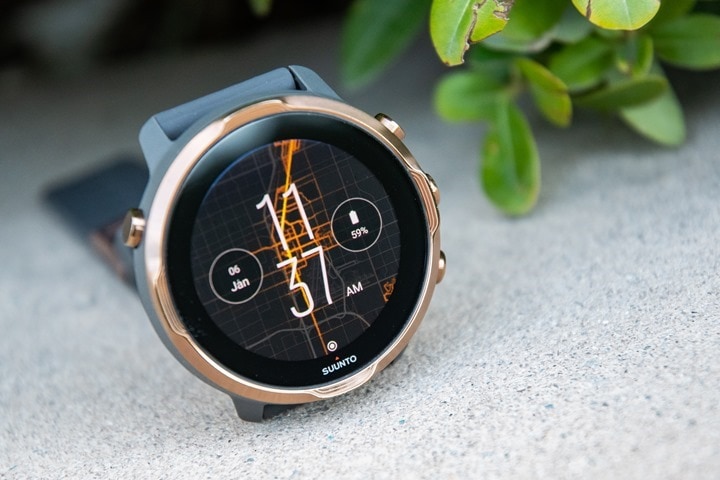
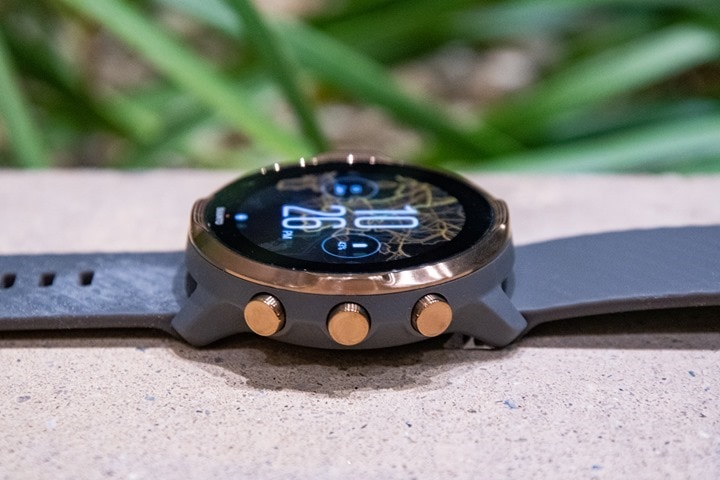

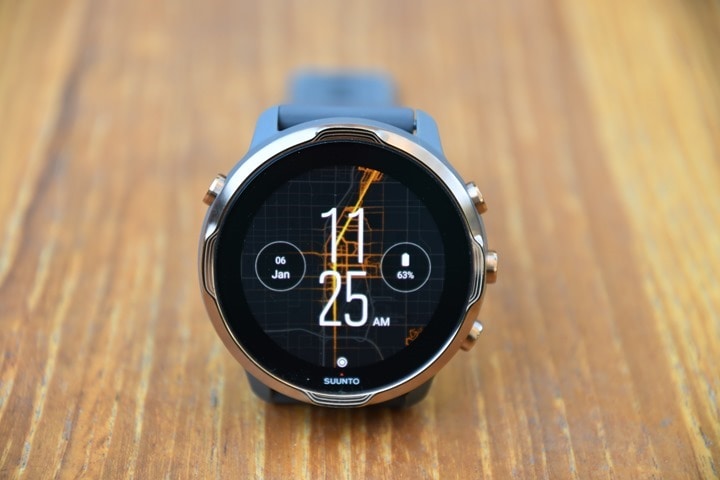
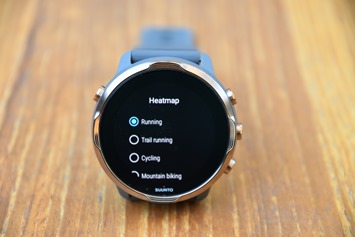
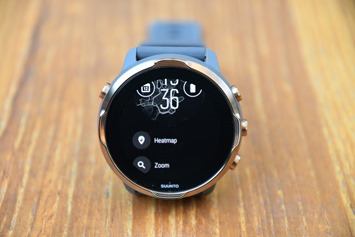
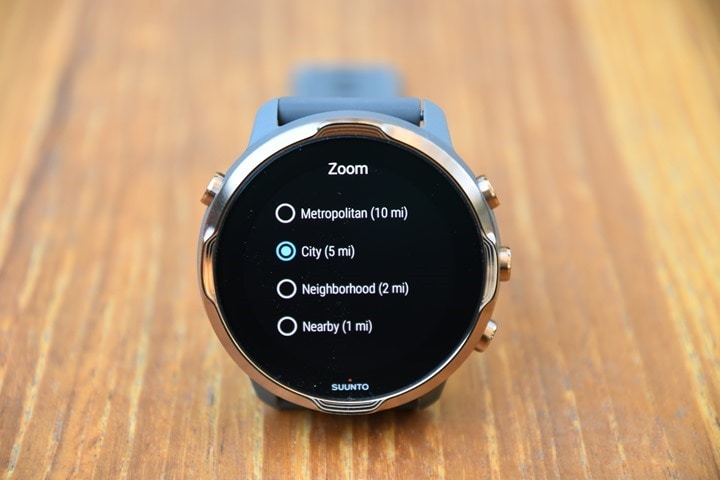
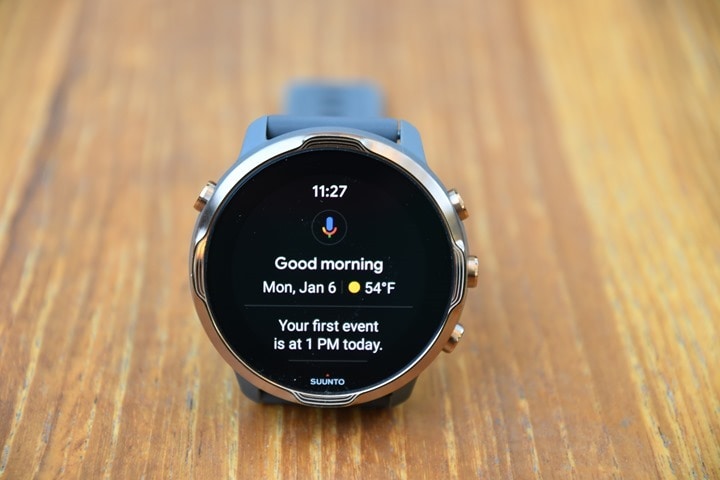
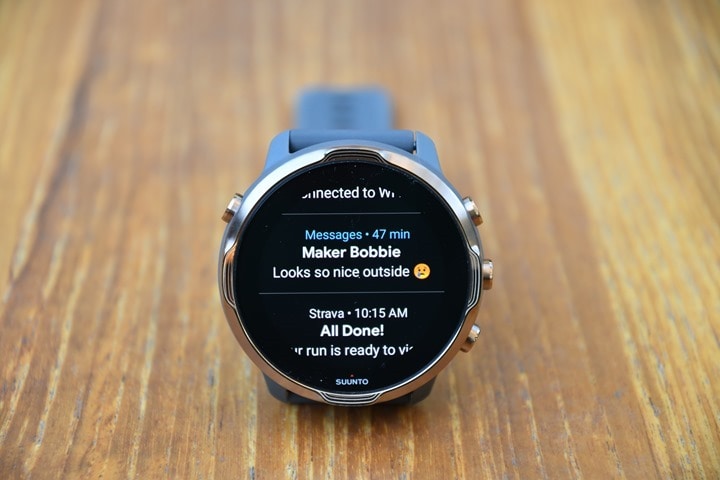
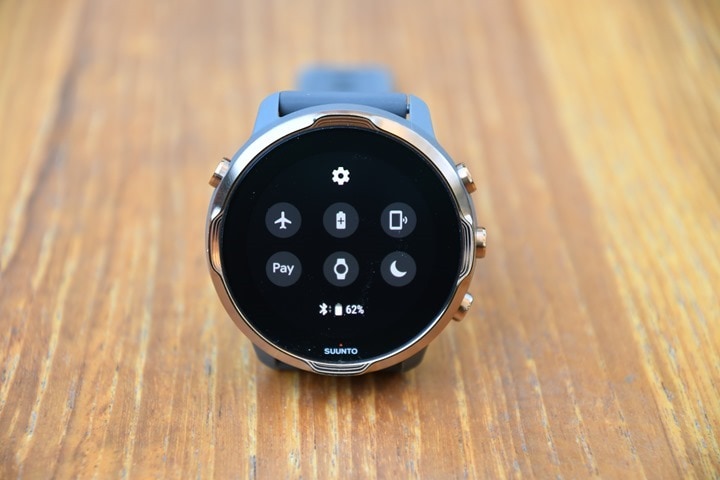
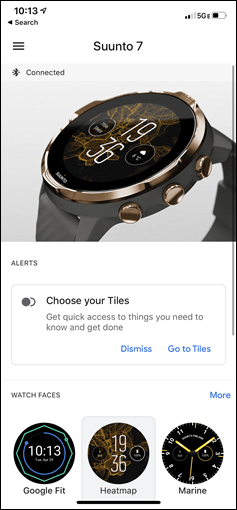
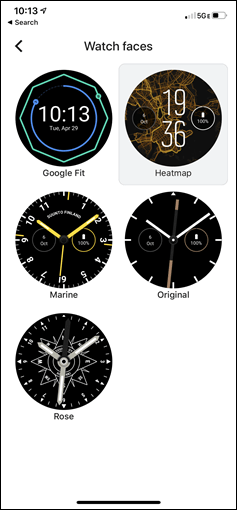

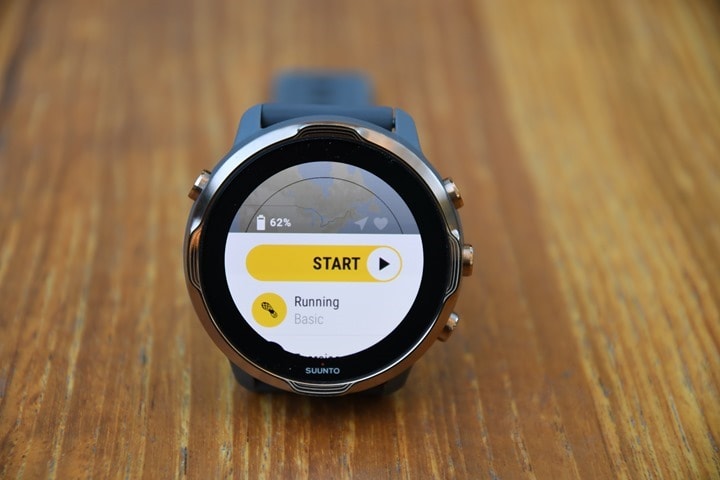
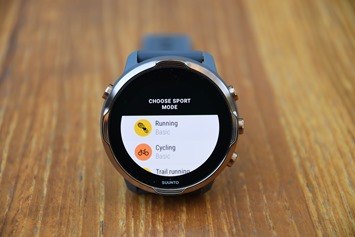


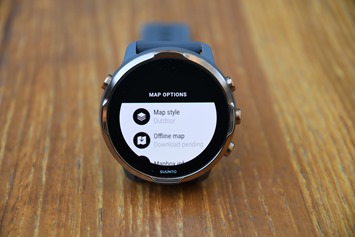
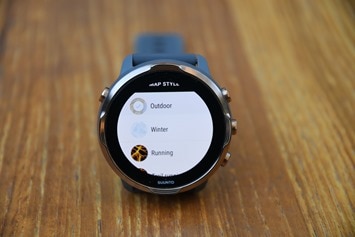
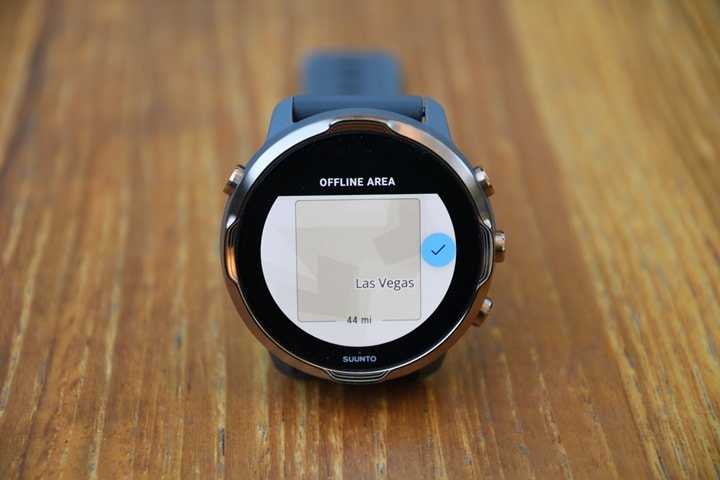
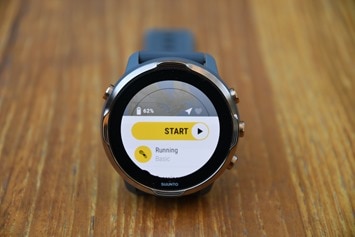
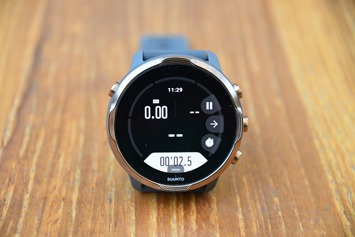
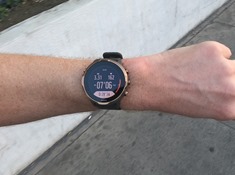

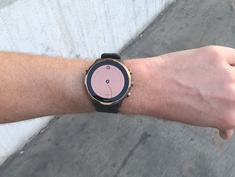
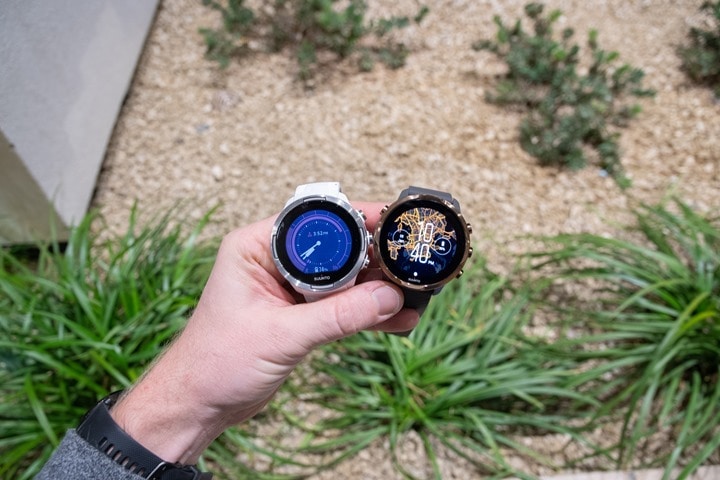
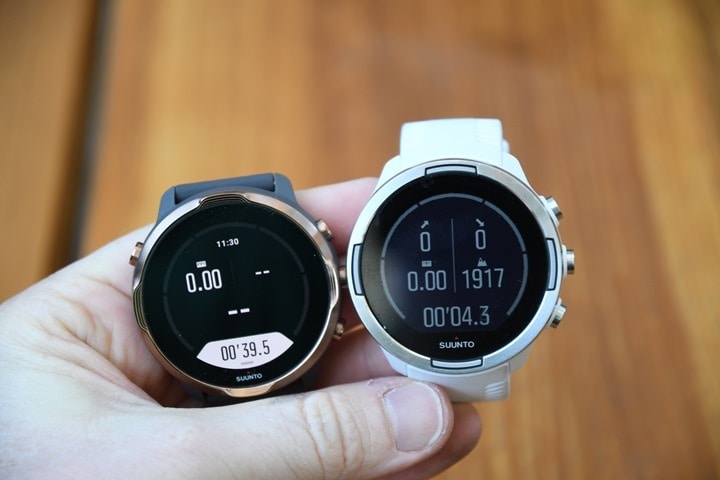

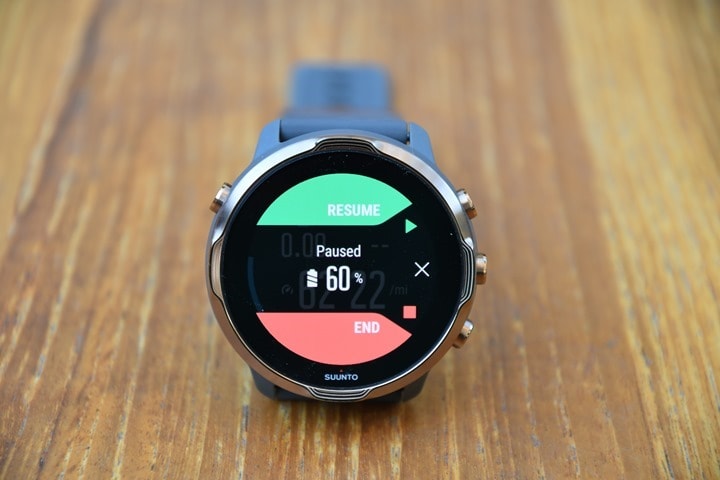
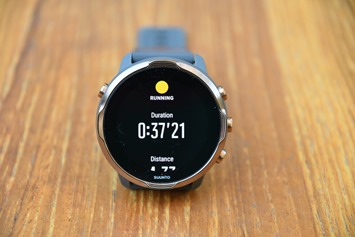
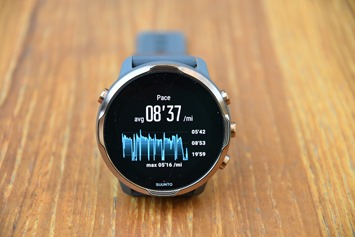

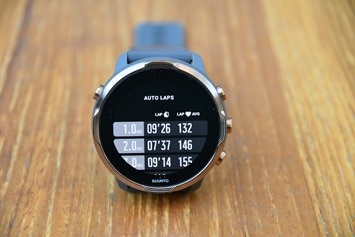



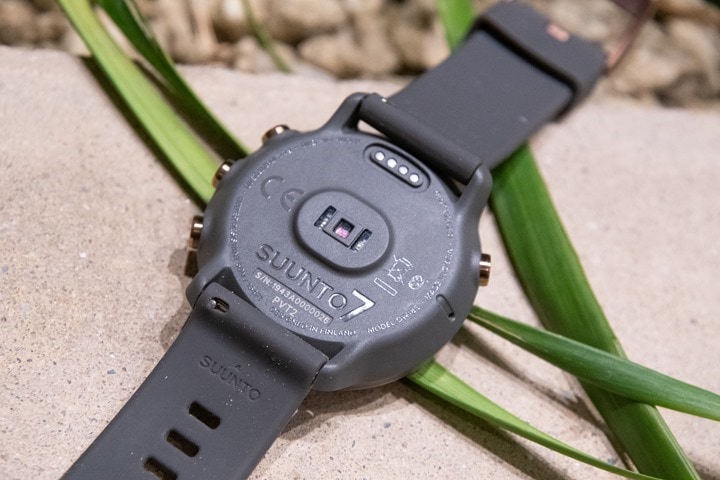

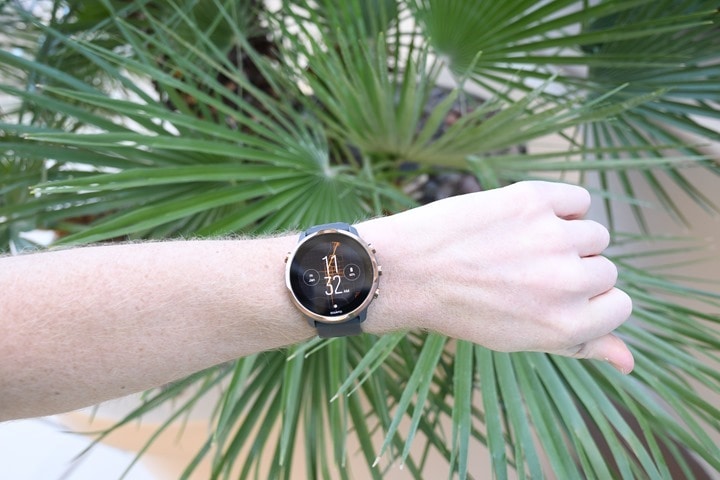
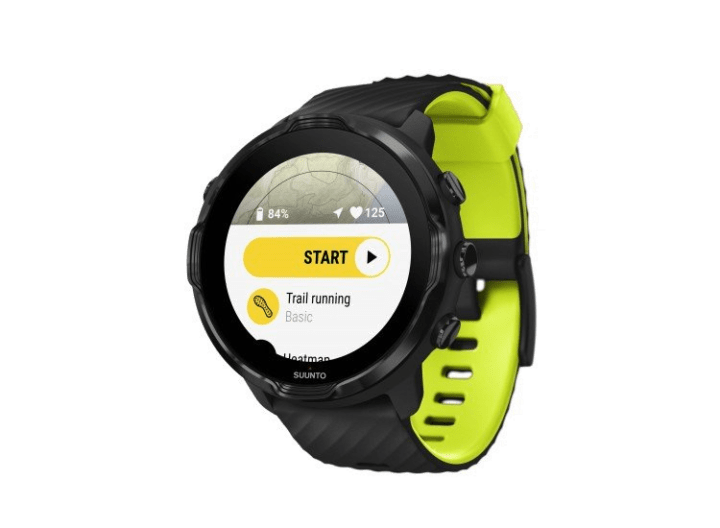





















Polar tried Android Wear OS with their M600. Became no hit…
That was a long time ago, with very different hardware. The M600 was basically a donut wrapped around your wrist.
Still it was a great watch.
It still IS a great watch. I’m waiting for a watch that ticks all my boxes before I upgrade (and I really want to get a new one, but there is just nothing – yet).
Three most important points for me:
– Android support (got rid of my iPhone and don’t want to go back) – hence no apple watch (for now)
– Wear OS watch because I can use specific programs in the gym that allow me to leave my phone behind (rep counter where I can define lifted weight and reps (manual) and rest timer)
– enough battery life for endurance sport (for example hiking 10+ hours)
The last point is where my aging m600 struggles – and it’s damn ugly…
This would be a killer watch with a cellular connectivity.
Agreed! One thing that’s always stopped me from getting an LTE watch (as a supplement to my Garmin) is that there isn’t a single respectable app on either platform for real athletes.
I’d add that the flipside is that just adding LTE to a true sportswatch doesn’t automatically mean that the full potential of LTE will be realized. It’s one thing to have LTE uploading of workouts and messaging to a dedicated email address. It’s another thing entirely to have stuff like number shared text messages, the ability to call ubers from the watch, etc.
The killer feature of an LTE smartwatch is, for me, being able to leave my phone at home.
This! (Ditch the phone so I can live track, text replies, stream music)
Interesting development. However, I can’t help but now think that the Suunto looks eerily similar to the Ticwatch.
The Ticwatch has all the features of HR, Spotify, NFC, etc…perhaps layering on the Suunto nuts & bolts would make it a dynamite watch?
if Suunto is in the hunt for battery life (amongst other things) while delivering the WearOS experience, is there any chance that Suunto will make a bid for Ticwatch?
Looking forward to see where this goes!
First impression said hell yes. Great replacement for my Spartan Trainer… and then i saw the price
Interesting! I agree this is to expensive. They have been out of the common consumers mind for so long they need to have a lower price to get them onboard. They might have a possibility in the future to increase if this is a success.
It looks really nice and that is super important to get volumes, but I think this competes with Samsungs Gear Sport. The consumers that does not want a Apple Watch, but feel the Samsung does not look good enough.
Cool idea by Suunto, though if Helsinki also posits as a Hail Mary, the TAM sure looks narrow.
Agree with Kristian: this is alternative to the Samsung daytime smartwatch user. Maybe one that runs a Turkey Trot and runs Android. Concern there is price is prohibitive — doesn’t Samsung give those damn things away with new Galaxies? Also not sure that crowd is looking for a hulking beast. This is bigger and thicker than fenix6.
For the swim bike run crowd — no sensors, bad battery, movescount versus Google Fit dynamic Plus the US iOS world will just stick with AW.
If removing the Suunto label this would almost resemble a Google Fit driven PoC.
As DCR notes, that heat map watch face is brilliant. And could downloadable maps be the future in a 5G world? Though NAND so cheap not sure what that solves.
This helps accelerate all multisport — cough fenix — to AMOLED.
Is it just me, or every time Suunto change something they seem to remove themselves a little more from the product? First the movescount fiasco where functionality is still MIA that had been there for years in their own platform, and now this where sensors and other important Suunto features (like syncing fit data with their own app!) is missing.
Didn’t anyone at Suunto, in any meeting at all, speak up and ask why a customer would want a Suunto badge on this? It may be a nice watch, but Samsung also have nice watches. And people have heard of Samsung outside of the compass using fraternity.
I’d purchase 3 different SST (2 normal, 1 with the metallic bezel) and I returned all three because the OHR was extremely inaccurate at least the 5-10 first minutes, and afterwards depended on the day.
I hope the new HW and SW combination works!!
Looks interesting, if a bit fragmented between two systems pushed together in one product. My biggest concern if I was to go for this watch is there is a lot of things that *may* come in the coming weeks, months, years. I have been burnt before on promised updates that never arrive (not from Suunto I may add). Always buy tech for what it can do today, not what is promised. Is that too cynical?
They need to come up with a clear roadmap to convince people to turn to this watch over other offerings. For me there are also too many question marks for the price tag. Just look at Polar and people may adopt this new option.. But looking back, I rather expect less than more of future updates. Time for suunto to deliver hard here, or have another fiasco at hand
I’m went from my Ambit 3 Peak Sapphire to a Fenix 5X Plus kind of semi-reluctantly, mainly because there wasn’t much in Suunto’s lineup that grabbed me last year. Glad I did now, because I got my Fenix for a decent price and I’m still not sold on these new Suunto offerings! Hope it works out for them though!
My first impression was that it is a nice smartwatch on the wrist. The design is quite good methink.
Although based on specs (no sensor connectivity,2 days battery life) already beaten badly by Garmin Venu (sensor connectivity is better, battery life is similar or better, has Garmin Pay).
And as Ray stated for Garmin Venu, the pricing is off (399 USD seems a bit much), so 499 for less funcionality (even bit better design) isn’t gonna cut it in 2020 I think.
Would you suggest the Garmin Venu over the Suunto 7 in that case? In between the two at the moment.
No sensor ? no watch – certainly not at that price
Could you please explain what is possible in the 40 days time only mode? Steps count? HR measure? Notifications? How to switch back to smartwatch mode?
I’m going out on a limb here, but I guess it is TIME ONLY – as the name says.
Yes, that could be. But there is no technical reason for it because my some years old Ambit 3 could do this and still the battery lasts for werks. And having the possibility to use WearOS feartures like Assistant, NFC, Maps is not a technical reason why in a low power mode it should not be possible to provide these old features.
Hey Bernhard. It’s a bright clock face and that’s it. The watch also drops to this mode when the battery runs low.
Basically the Suunto 7 is all I ever wanted. But the lack of support for external sensors is a deal-breaker for me.
Let’s hope they look into that in the future and I’d gladly move from the Suunto 9 to that.
What about concepts of privacy or security. I didn’t find anything about that. Google is a huge advertizing/marketing company and their software, hardware and services all feed into that.
I don’t want to have my personal data (incl. sports, activities, etc.) leaked to Google and from there to various companies, to which Google sells this data.
Suunto and its watch customers don’t care?
You can technically choose not to use Google Fit (or even not use a Google account at all). How that works in practice though, I haven’t actually tried.
It’s good that people have become more aware of integrity issues but avoiding google fit is ridiculous if you at the same time do anyn of the following: search for stuff on internet, browsing with cookies, using a free mail service or hang on any kind of social media or use any cloud platform or streaming service.
Google does not sell personal data to anyone. link to safety.google
With barometer it’s kind of tempting. But a roadmap would be nice for page customization and at least bluetooth sensor support. ANT+ would be also nice, but it requires hardware upgrade not just software if not already inside.
Do you happen to have a pre-order link for European readers as well?
Agree. At a minimum bluetooth support for sensors and I would seriously consider it since it has a barometer.
To get this product off the ground, they need to appeal to their base, who are the people who know them; as they simply don’t have the reach to pull in large numbers of new customers, when Samsung, TikWatch, Huawei etc have decent WearOS offerings at half the price. I understand this is a new and brave attempt to create a proper sport watch with WearOS, but one that doesn’t allow sport-mode configuration, and most damningly, no support for external sensors… no serious athlete will touch this. I know I won’t – I won’t train on the bike without power, and I just don’t get on with wrist-based HR at all, on all platforms.
I’m actually gutted, as I was genuinely excited reading the press release. This was the watch I’ve been waiting for, for some time, but it _still_ doesn’t meet my needs fully. Suunto really need to pull their heads out of their ass – the Suunto App limited functionality, the drip-feed updates to Spartan users (particularly those with WHR watches; no logical reason to exclude those from the current updates available to 5/9 users), and the one-way communication on social media; this is all killing them.
Hey Ray, you forgot to mention something key…
Is there off-line Spotify?
Cheers
No. There’s a Spotify Wear OS app, but it’s basically as useless as the Apple Watch or Fitbit Spotify apps – just for controlling Spotify. No offline caching.
It fear it’s gonna fail. Yes, hardware and software is way better than back in the days when Polar M600 was released (M600 had no barometer or route navigation and was really ugly). But no way to pair it with a HR strap? That makes it a toy.
Does it handle pace on a treadmill?
If so, it actually seems like a possible replacement for the trainer wrist HR, other than a big price jump. If no footpod is needed, I don’t know what sensor I would ever pair with it. I prefer a separate bike sensor.
I’m sure it does via accelerometer. So if inaccurate pace and inaccurate hr is not a problem, this watch is good buy…
It actually has a very accurate HR. Probably the best whrist HR on the marked.
I don’t see any proper strategy from Suunto: Discontinuing Movescount, lacking full functionality in the suunto app and now introducing GoogleFit into the ecosystem. My Ambit3 has more sports functionality and battery life than this S7 and the S7 WHR sensor looks similar to a 2014/15 Tomtom Cardio Runner. So I don’t see this as progress at all. As others have mentioned; there are cheaper WearOS devices out there. If WearOS opens doors for future improvements as suggested, then why release a model now? Developments in sensor support, multisport support and battery life should be invested in first.
I’m holding on to my scratched but still solid and functional Ambit 3 Peak for as long as it will let me. No watch since has moved me to replace … Suunto7 included.
Is Valencell starting to have atrial fibrillation? (Of the mainstream oHR’s using Valencell’s oHR sensor only Scosche is left with the year old Rhythm24 IIRC?)
Based on my owner experience of a Suunto Trainer watch with a Valencell oHR it is no great loss though.
Any idea if the Google Map functionality will come to the Suunto 9? It would be nice for their top of the line watch to get something similar to what you’re seeing with high end Garmin watches.
None of the innovation here comes from Suunto. Zero. It’s not even the Suunto fitness platform. All they’ve done is slap a Suunto badge on a watch someone else designed, and make the menus look like their own watch in an app someone else designed.
So no. Don’t expect anything on the Suunto 9. At this point I’d be amazed if the 9 ever gets updated to be half as functional as an Ambit 2.
I don’t think that this is true. If you check the reviews, it makes use of the low power processor of the snapdragon 3100 chip for sports usage. In addition to that there seems to be a Suunto app on the watch that you use to track workouts, use maps etc. So I understand that there is plenty of Suunto sports tracking software in this watch.
That’s the app they bought, which contains very few features they had in their old app. The processor is the one chosen by the chinese OEM they buy the watch from, it’s not like they did much to design the platform here, Google call the shots on what’s supported and Qualcomm give a menu of options. From my perspective this is dead in the water as it doesn’t have anything special from a sport perspective (and lacks a LOT compared to a low end Garmin or 5 year old Suunto) and doesn’t have the brand of a good WearOS. Why would anyone buy this aside from the cool background on the watchface (the only original thing here).
Minor note: Technically speaking the ‘Suunto’ app on the watch is a native WearOS app they built from the ground up, alongside Google. They’ve been working on it for two years. I spent some time with the lead developer last night at CES and chatted a bit about it.
Which is different than the Suunto app on iOS/Android, which has roots from the Sports Tracker days.
So there are two apps that an undermanned group of developers has to continually update and provide innovation to? Ya that sounds like more of the same from Suunto.
Not sure I follow?
They’ve discontinued Movescount – so that’s out of the picture (that app disappeared from the app store back in December). There’s only one smartphone app now: The Suunto app.
And then there’s the Wear OS ‘app’, which is basically the entire Suunto watch inside an app. Sure, they have to maintain it, but that happens to most wearable companies as they shift from platform to platform. Undoubtedly much of the code is re-used…and if Wear OS is Suunto’s longer term vision – then that makes even more sense.
I don’t disagree with you that I think Suunto is woefully understaffed on development resources. But in theory this actually helps them, as they’d stop having to deal with the entire underlying platform, as Google would take care of it.
I mean if their vision for the future is full integration with WearOS and simply developing high end hardware and applications for their hardware a la Microsoft under Nadella that will probably work. In this scenario though they will probably struggle similarly to Microsoft under Ballmer with the uncertainty of pushing forward with a single vision especially considering they have struggled to produce ample updates and merge multiple visions of/for their already lackluster software. As you pointed out in your first hands-on, over the past 1.5 years this company has if not worsened definitely stayed incredibly stagnant, and this watch isn’t necessarily a step forward as much as it is a step sideways into a different field. I see this as similar diversion of their vision, not unlike the one they tried to move away from with the Movescount and SuuntoApp. I know this is a relatively esoteric discussion on the vision of a company which I have no personal experience/knowledge of their goals, but just by analyzing their actions since 2018/19 I think we all have a pretty firm grasp as to their faults.
You are pretty far from the truth here.
That is basically the main reason I decided to leave Suunto brand after being a user for 7 years. All their focus will now go towards the new platform and I really doubt that Suunto 9 will see any further innovation or much needed bug fixes. I feel am no longer a target user for the brand.
I like the design and function. The price kills. Now I can buy with pre-order. :D Am I correct that after pre order the price will be different?
Autocorrect issue – ‘Ability to great routes’ should probably be ‘Ability to create routes’?
Sadly there’s little that Suunto or Google can do to improve the battery life, even if they ship software updates.The limiting factor here is the processor which is just not very efficient. And Qualcomm aren’t really busting a gut to improve their product here because they are your only choice if you want to make a Google Wear smartwatch.
Warning – nerdy tech stuff ahead:
To quote Ars Technica:
“If Google really wants to fix Wear OS, the first thing it needs is to secure a good SoC supplier. Today, no component vendor sells a good smartwatch SoC that a company like Google can buy. Qualcomm is really the only game in town, and it doesn’t seem to care about the smartwatch market. Qualcomm has had three major “generations” of smartwatch chips: the Snapdragon 400, the Snapdragon Wear 2100, and the Snapdragon Wear 3100. Fundamentally, these three chips, released over a four-year span, are all the same. They all use Cortex A7 CPUs built on a 28nm manufacturing process, which was state-of-the-art smartphone technology back in 2013. Qualcomm hasn’t invested in building a serious smartwatch chip and instead only pays lip service to the market by repackaging the same core technology year after year.”
Source : link to arstechnica.com
So the “newest” processor is “fundamentally the same” as their 4-year old 400-series processor, and built on an archaic 28nm process. Contrast that with the Apple S4/S5 chips used in the Apple Watch Series 4/5, which are built on a 7nm manufacturing process, which makes them more power efficient.
Even Samsung know that Qualcom’s smartwatch processors aren’t good enough, and use their own processors (and their own Tizen OS) in their smartwatches.
Yes I know this relates to general smartwatches and not dedicated fitness watches, but Suunto has gone down the Google Wear line so it’s all relevant and worth knowing. Especially as you started this piece by saying : “How this story ends will take a few years to flesh out, but just most Hail Mary attempts it only ends on one of two ways: Astounding success or utter failure.”
This is a great post, thank you. Makes me shift away further from buying this.
Agreed, but the thing that really improves battery life on sport watches without WearOS is the transflective screens?
Yet Garmin offer a more performant experience on a a single A7 core SOC. It’s got very little to do with the processor and everything to do with the OS. WearOS is simply too inefficient for wearables.
I think I still have a Suunto Microsoft SPOT watch kicking around somewhere.
Send all your data to Google? No thank you!
To bad. Garmin’s software bug and useless features become more and more annoying. Polar lacks navigation features. Now Suunto chooses for Google.
Just create a fake account like I assume you have done when browsing the web, using social media or free email services with cookies disabled
Where can I do for pre-order?
On suunto site.
There is a link at the bottom of the review that supports the site as well.
I am not sure weather longer battery life really is a priority for Google and “the industry”. They haven’t delivered Android phones that don’t have to be recharged every night after all these years… (apart from a few special purpose devices with very large batteries that you won’t usually see in stores). Everyone in consumer space seams to be fine with that. Brighter displays, thin cases and flashy animations seam to be much more important. I don’t think the market for smartwatches is that much different.
Former Peppble users and endurance atheles are constantly asking for more battery life (with always on display), but these are tiny markets compared to the general public. Does Google really care?
Just jumping in to point out that I can go two days (36 hours – day/night/day) with moderate usage on my Pixel 3 without charging it.
Not defending Google, Suunto, or anything else. I’m sad for Suunto – they gave me my best watch ever in the Ambit 2. Looks like in 5-10 years they won’t even exist.
Ray – I think you are spot on with the price. While I imagine that there are suunto fans out there that might buy this at $500, I don’t think most people looking for a sport watch will venture that high when you can get other watches by Garmin/Apple/Polar/etc. For significantly less. Even if you are married to Wear OS, and even though this is clearly a superior watch to almost all of the fossil offerings – is it worth 2x the price? (3x when you consider that the fossil watches are on sale often).
I wonder – if they are taking the time to pivot to WearOS, how long is it before we see either:
– A Jailbroken version of their app running on a Fossil Sport Watch
– Or maybe suunto offering their app as an option on other wear os devices (highly unlikely, but maybe as a last ditch effort).
We never saw a Polar jailbroken app on Fossil watches, so…
I won’t be extremely worried about the pricing, considering that Amazon usually sells Suunto’s devices at their ‘real’ price (even weeks after their release)…
As much as I love Android, WearOS is just not very good. I’ve tried (Fossil Sport) but as a fitness/gym person I want the data metrics to be accurate and decent battery life. First, the data (calorie/heart rate) was rubbish with HIIT/Strength training. It was basically good for running and the casual gym goer. The battery was terrible as after a 2.5hr workout I’d need to recharge the watch or it was basically dead.
I moved to the Garmin Vivoactive 4 and have been very happy with it. Yeah, it doesn’t syn directly with Fit but the work around does its job. Can this watch bring me back to WearOS? So far everything I’ve read I’m still dubious so I’ll wait and see plus the price tag. Wowzer!
I have several watches. I mostly use Apple watches. I buy the newest each year. I also own Suunto and Garmin watches. I find the Suunto and Garmin watches hard to use. I just bought the Garmin Fenix 5 Plus Gray w/ Titanium orange band. I want a watch that’s easy to use. I want always on time, sleep and heart tracker and an easy to use topography maps for hiking. It was easy to use at first but switching between functions have been a problem lately. I am not a dedicated in training athlete. I just like to stay in shape and in touch with my body and the world.
Hey Ray,
What version of the Suunto App are you using? I cannot get the “use in watch” icon to display for any of my routes in order to sync them to the 7. Is there some special workaround you are using? I am running SA beta, as I am a tester for Suunto. Thanks!
Yes, it’s a beta version of the app for the beta watch. As noted though, it didn’t actually sync them best I can tell, so I suspect that part is also still beta-beta.
Whoa, I thought my eyes were going with a couple of the pictures that seemed not 100% in focus…but I get the idea.
I think the part of the risk is the Wrist HR Sensor and GPS chip.
Shooting these photos in poor light is near impossible with AMOLED screens. Good news is the sun is up, and once I finish waiting for the battery to charge up enough – it’s out for a run and back for better photos.
They also seem to have some kind of blue tint… Specially bad in link to media.dcrainmaker.com the bottom should be “more” red and the top blueish button is green ?
Great post and break down. So to confirm – no FirstBeat analytics so Suunto is now calculating their own algorithms? Or is that LifeQ? Obviously the EPOC, PTE, and Recovery time is there – assuming no Resources (Body Battery), and so also no Stress/HRV built in?
This is definitely a step in right direction with a little more analytics than Venu/AW5/Fitbit – but uncertain if the Suunto team can run their own deep-dive analytics for output calculations, right?
And assuming the HR details are accurately tracked via the optical, of course – and will it be possible to turn on bluetooth HR sensor pairing via an update at some point?
Is this physically the same size as the Suunto 9 Baro?
Slightly thinner. Measuring mine with a ruler, my S9s are about 15mm with the WHR sensor. My S7 is about 13mm.
This would be killer if it lasted atleast a week. The problem with wear OS is it uses the Qualcomm 3100 which is years old. After owning my Fenix 6, while not intuitive as wear OS or Apple, it last me 20 days just in watch mode and days when I go on Hiking trips. Suunto probably should have just developed on their already existing OS and implemented OSM apps. At the same time, wear OS does offer a ton of features..just needs battery life which is terrible. I still dont understand how ppl who wear the Apple watch like to charge everyday so I guess I’m in the minority.
Battery life is cool, but I think I’d charge every two days for a version of this that had a barometer and Ambit-level GPS.
It has a barometer.
It does not have Ambit level GPS.
oh dang I missed that thanks
? one day one will though
Does it do under water OHR?
I just pre-ordered one :)
No external sensor support is the biggest drawback. I’m not sure how they can compete without this support.
(No BT heartrate, power meter, etc etc)
A che modelle Garmin lo confronteresti?
Which Garmin model does it look like?
Is it possible to install Polar Beat app on this Suunto watch and use it with Polar Flow ecosystem?
Actually that’s a brilliant idea!
Too deeply invested in another ecosystem to consider purchasing, but it is an interesting development. Assuming it is more of a stepping-stone than an end point.
The heat map watch face is genius. I hope it is cloned extensively.
No Sensor Support.
Well, there goes all the training athletes. Why every Smart-sport watch refuses to support the bevy of external sensors is beyond me (other than Apple I think).
This is why Garmin has just so much of the market share: everything connects with Garmin.
Garmin has no (working) user support.
Garmin gives a damn on user’s suggestions, they leak a lead person with vision like Steve Jobs was.
Garmin doesn’t connect to IFTTT.
Garmin gathered everyday persons with their fitness range, but neglected athletes.
Garmin Connect is the worst platform and actually getting worse with every update.
Why has Garmin the majority of the market share?
Because existing users have their activity history in Connect, they have their connections in Connect.
And it is not transferrable for instance to Polar Flow. So they will rather suffer like in a crashed marriage…
Will you switch from SAP to Oracle if the data wouldn’t be transferrable?
Why has Garmin the majority of the market share?
Because, driven by their marketing department, they add more features to their watches than the competition. Even here on dcrainmaker, the fenix watches are chosen as best watch of the year because “it has the most features”
If you own such a watch and start to look in the usefulness of those features you see they are either not well implemented, complete useless or don’t work at all.
I too fell for the feeling of missing out on features. Now I know that’s not the case.
I do like my forerunner 935 for it’s compact/light design with good battery life, fast gps fix and good readable screen. But no need to buy a newer 945, because it doesn’t do the basics any better and other extra features are worthless.
“If you own such a watch and start to look in the usefulness of those features you see they are either not well implemented, complete useless or don’t work at all.”
I see people say that, and yet, every bit of actual hard data points to the opposite. You can pick the metric: Sales numbers, interest in products, feature requests built atop those other features. It doesn’t seem to matter.
The thing is – people seem to think that every feature will be for them – and failing that, it’s a “useless feature or device”. It’s not. There are some features that some people want, and other features that other people want. You’re never going to use every feature. Your most important feature may not be a feature I ever use. And vice versa. Yet, in combination – it’s why Garmin dominates here.
Let’s take ReHMn’s request that “Garmin doesn’t connect to IFTTT”. Sure, I can see the value of that, but 99.5% of people can’t. To him, that’s an important feature. To me…shrug.
Or, this comment: “Garmin gathered everyday persons with their fitness range, but neglected athletes.” – Which is so diabolically opposed to what Garmin has actually done with their products in the last 2 years. Yes, they’ve added features that appeal to a wider audience, but so much of the higher end has been adding features that endurance athletes want, or people training for events want. Actual data driven metrics.
As I’ve said numerous times before – Garmin isn’t perfect here. But if anyone thinks that the solution is to stop adding features across the board and do nothing, they’ll find Garmin positioned as the next Suunto or Polar.
I appreciate your reply (and love reading your reviews)
Sure, sales numbers are sky high and people actually chose garmin because it has more features.
I also read the garmin forum. People are freaking out because their watch report the wrong sleep stats. How do you know I then ask. Because their old fitbit was right, they claim.
People have no idea if the stats are right or not, but they buy a watch which reports the most stats. (And then again, who needs a watch to report if they had a good or bad night sleep?)
Same for calories used. It’s just based on statistics with some correction for weight and heartbeat. If you want to know if you eat to much for the amount of workout step on a scale every now and then.
Thermometer? It doesn’t work. It’s always somewhere between my body temperature and the outside temperature. (Last sunday I did a bike ride in the Netherlands and my forerunner 935 reported it to be 19 degrees. really?)
Barometer? It’s always of compared to weather services air pressure. And my watch reports sudden drops in air pressure that really don’t actually occur.
Like I said, my forerunner 935 does the basics al right, but really no need to buy the “improved” 945. But I do which they stop adding features and start to fix bugs in their software. There is something they really can improve things.
But this is my opinion…
Well, 945 brings maps and music and NFC payment for your ad hoc mid-run beer pit-stop and longer lasting battery, and quite a bit more. It is quite a bit improved compared to 935.
I certainly don’t feel trapped in the Garmin ecosystem. You can’t argue that my workouts aren’t portable as I have a decade worth of training logged in training peaks from polar, timex, TomTom, and Garmin.
“Let’s take ReHMn’s request that “Garmin doesn’t connect to IFTTT”. Sure, I can see the value of that, but 99.5% of people can’t. To him, that’s an important feature. To me…shrug.” I had to look up what IFTTT was. After I found out…shrug.
Ray, I wish I could talk to you once personally…
Connecting to IFTTT is not an important feature to me, I was pointing to the fact, that not everything is connected to Garmin, even if the subject was a sensor, not an application.
As a matter of fact, I am fine with my 910XT, 920XT and Edge520, these have all the features I need.
But I see huge opportunities being missed from a medical perspective.
Imagine a GPS wearable on kids, and grandparents.
You could be set an alert for preventing kidnapping by setting up a condition: If This wearable is out of this area, send me an SMS.
Or If my grandfather’s pulse falls under 50 bpm, find the nearest CPR unit in that area.
I find these more useful than a wearable capable to make a 10sec ECG record.
What is happening right now is an opposite of the development. What was good, working well and useful in the past, is now disabled. For example:
Searching activities by map area.
Proper graphs, scaling and units on activities.
Also, forced users to make their profiles private, but forecasted that users will share their training plans. This is the biggest bullshit.
Garmin killed bike profiles present in 910XT.
Garmin badge pointing was set up by somebody who has no idea about activity difficulties.
…and the list goes on…
“Imagine a GPS wearable on kids…” That reports to Google? I’d maybe trust Apple with something like this. But having a tracker on my kid that reports to Google is a non-starter.
The medical things you talk about put a lot of restrictions on device manufacturers, because medical data is very sensitive and there are privacy laws that affect it. I’ve always thought that’s why the Apple Watch is such a poor fitness device, since it’s always seemed to me that Apple aspires for it to be a wearable medical device much more than they want it to be a Garmin substitute. I don’t think Garmin wants any part of that.
Very good point, Paul!
Where 99,5% people shrug, the rest 0,5% see opportunity.
It is like standing on a riverbank and watching fishes – shrug. But if I show you a fishing tool, a method of how to catch a fish and how to cook it, it turns a different story.
… and I strongly disagree with your statement about medical data, the explanation would be a big discussion, so shortly:
The biggest harmful step was to connect the athlete’s ecosystem with social media. The hunters became hunted by marketing strategies and revenue eager rats.
On the other hand, revealing medical data can be only useful from a diagnostic perspective or disorder detection…
Same for drones. It is just a question of approach whether you use them to carry weapon to shoot somebody or for a CPR unit delivery when needed…
Garmin has a whole health devision. I’d say it’s definitely in their plans.
Sure…That’s why they terminated the cooperation with Tanita a long time ago…
Since then they flood the market with innovative solutions and products related to the health division.
Wintertime clothing means I can either get wrist HR OR see my watch; therefore a chest strap is required for both. No external sensor support is a dealbreaker.
Who is supplying the heat map data, Suunto or Google since the watch has components of both companies?
It can use a Bluetooth HRM just fine, all Wear OS watches can
@Storz, no, it doesn’t support BLE sensors. WHR only. You can _pair_ a BLE sensor in the system settings, but the Suunto WearOS app won’t try to utilise it.
@Ken, the heat map data is Suunto’s. It’s pretty funky – the watch face heatmap updates and moves as you do.
I am in between the Suunto 7 and the Garmin Venu. I’m looking for a do-it-all watch that easily tracks various health stats and workouts. These two look very similar and maybe you’d have a suggestion?
sadly, hardly any of this is appealing. i want a nice watch from suunto, not google. will stick to the 9 for now.
Hey folks – for those with comment subscriptions on this post, just a heads up I dumped in a bunch of new photos today that are much crispier, as well as some additional features/bits covered.
Plus there’s an entire hands-on video as well at the top of the post (or here: link to youtube.com) that has 10+ minutes of user interface walk-through of all the menus and how things interact.
Why can’t suunto find there way??
They don’t have to go feature to feature or trade blows with garmin.
There is a No win Iam that scenario …
The formula is simple and they already have the tools..
Long battery and good satellite connectivity and ability to design quality watch cases and straps..
Most importantly Price or less than garmin …
If your price is same as garmin people are going to buy garmin
Business 101
Don’t over think it,,,
Why can’t suunto find there way??
They don’t have to go feature to feature or trade blows with garmin.
No win there
The formula is simple and they already have the tools..
Long battery and good sattalite receptors.
Make a watch that is
I think that the Hail Mary is spot on. Suunto (and others) are in a downward spiral. They don’t have the market share to make the money to innovate/lead, so they fall behind to those who are killing it and, therefore, fall further behind. Unless there is disruptive change, they fail to exist in this market, eventually. So, they are essentially farming out – to Wear OS / Google – the development of significant portions of the device. Suunto *only* needs to worry about the sports-specific pieces (and how to integrate those with Wear OS, presumably). They need fewer resources to pull that off, which is convenient because fewer resources is what they have! As others have mentioned, the lack of sensor support makes this device DOA for me at any price. Even with a full set of BT sensor profiles, I agree that this is overpriced. BUT, the battery life is less of a concern to me – I don’t wear my endurance watch as an everyday device, so as long as it comfortably lasts as long as my longest workout/race, it’s good and this device does that. And I have a Suunto Spartan Wrist HR (or some such – those names are too long!) and it’s fine, but I use my Garmin device most often. Honestly, I think that this is more than a Hail Mary and more of a last gasp. If this does not generate some ‘breathing room for Suunto, we are likely one step closer to a monopoly (or a duopoly) in the endurance fitness wearables space (which is a shame).
Why can’t suunto find there way??
They don’t have to go feature to feature or trade blows with garmin.
No win there
The formula is simple and they already have the tools..
Long battery and good satellite connectivity ,
Stylish watch cases with bands made of durable materials.
Don’t over think this ….
Price is less than garmin .
If The price is the same as Garmin people will buy garmin.
Business 101 my Suunto friends
Not necessarily. I had a Garmin Fenix. Since the beginning I suffered for bad GPS connectivity, suddently resetting when running (it’s a Garmin, you know, you loose your workout at the middle of the race, if you run you know how frustrating is that!), useless features in sports (who cares about my bouncing!!), tree HR bands, one for the water, other for dry environments and another I don’t know… did I mention the %$$%$^ battery?. It fails!. My first Garmin only lasts 6 months, then the battery died. The other (warranty claim) another six months and it died. Again!, It’s incredible the bad quality of the batteries they’re using. That was the time I said “Sorry Garmin, no more” and went to buy a Suunto. I didn’t know ANYTHING about that brand, but some time later, I fell in love with the quality, good GPS connectivity, long lasting battery, (still I have my beloved Ambit 3… such a piece of indestructible hardware and flawless software it is) and all the features I really want… so no need for another faulty Garmin in my life anymore.
That’s the real value of a Suunto. If they focus on quality, no need to worry about Garmin’s excessive (and for me, mostly useless) features.
Sure, in 2014 that was all true. Then Suunto made some weird choices, reduced quality, removed features, removed their working platform to replace with a much, much worse replacement. In the mean time Garmin really upped their game. My very old Garmin experience was similar, but from Fenix 3 onwards they’ve added features and improved quality. They never crash or lose data these days and pretty much just work. They aren’t perfect, but judge on today not some rose tinted view from the middle of the last decade.
What Suunto are you currently running with? I have the Ambit3, but while I love it, it is literally falling apart. The GPS is just so damn accurate I’m afraid to upgrade.
You can be sure of one thing (seriously). No matter what watch you replace it with, the GPS will be less accurate. Be it a new Suunto, Garmin, Polar, Coros…it won’t help
The Ambit 3 is one of the most precise GPS devices out there together with the Polar V800. In case of new devices only the 935/735XT comes kind of close. The Suunto 7 / 9 and all other new watches are far off from those older models. The Garmin 6X PRO and the Tactix Delta are also kind of okay, but the 6normal and the 6s are also sketchy. I compared like 1000s of strava flyby data during races, including crowded city running and trail events but also had my personal encounters with the Suunto 9, Vantage M and V and the F5/F6, 945 and 245. I am just disappointed !
Keep your Ambit 3 for the moment. Maybe Garmin will come out with a new chipset in the 655 / 745 / 955, but I cannot see contracts, fusions or buy-ins anywhere, so probably Garmin will still use Sony in these devices. The first company implementing the BroadCom dual band GNSS chipsets will be the winner in case of accuracy. If antenna design and firmware follows.
Unfortunate, this could have been a unicorn. I have a Fenix 5 and it’s an ok everyday watch but if it had WearOS behind it it would be fantastic. Suunto has the right idea but it needs Ant+ and Bluetooth support to be viable (multi sport would be great too). I’d gladly give up some battery life for an OS that can do real day-to-day stuff.
If Fenix 5 ran WearOS then none of the great things about Fenix would be there and it would just be another WearOS clone like the Suunto here. If you want a WearOS device then Samsung is probably your best bet and good luck with that. If you want a great sports watch then Garmin is the main player. I actually think I’d rather have a Venu than WearOS. It would certainly leak less data!
Samsung runs on Tizen, not Wear OS
So this is another WearOS watch that happens to have a really good training app and 4 buttons. That might not seem like a big deal, but it is. There are no other WearOS watches that have those things, and they’re the reason no other WearOS watches are any good for real athletes. Sure, it’s low-hanging fruit, but I for one am glad that somebody finally picked it.
I will say the lack of sensor support and customizable pages are baffling omissions. Hopefully they add those items very soon. If they do, this is potentially superior to the Fenix series in everything but battery life. And, let’s be honest, for most people battery life is a convenience issue rather than a necessity. It’s only a non-negotiable requirement for 100-mile runners and slower ironmen, and even then, it’s only for competitions.
” this is potentially superior to the Fenix series in everything but battery life”
Charging every 1 1/2 days is a nono for me. Sleep tracking is worthless if you can only do it every other day. And that 12 hour GPS takes most ultra’s out of the picture, as that 12 hr GPS life is probably with a raft of restrictions and in real use is probably closer to 8
Right, everything but battery. I had to charge my Fenix 5s every day, and it wasn’t a huge deal. I had an extra cable at the office, and I charged it for an hour while sitting at my desk before putting it back on. Is it as good as not having to charge it for 2-3 days like with the full size Fenix 6? Of course not, but it’s not going to be a dealbreaker for everyone.
As for the ultra thing, most ultras are 50 miles and under. The number of athletes who need to track activities that last longer than 12 (or even 8) hours is quite small in absolute terms. If that’s you, then obviously this is not the device. It could be the device for a lot of people, though.
Look forward to your review Ray. I like that Suunto is taking the gamble. I also do agree that $399 is the sweet spot in terms of price.
The heatmap idea is brilliant… absolutely wonderful for traveling. If Strava had a live wallpaper for my phone that would show me heatmaps for where I am, that would have been brilliant. They could have done that years ago, if not for their “don’t do anything new” policy! ;-)
Is it though? My first impression was the same but then I watched Ray’s video on YouTube and wondered how useful that actually is. I know Vegas but couldn’t work out which street was which from that screen, and it was a watch face so not useful when actually running. That leads straight back to some kind of planning app that uses the data so you can use it on a run, just like we’ve had with Suunto and Garmin for years now. It is a cool watch face, but I don’t think it’s actually genuinely useful.
There are four different levels of Heatmap Watchface zoom:
Metropolitan: 10mi
City: 5mi
Neighborhood: 2mi
Nearby: 1mi
The default was city I believe, which appears to be a 5mi radius from your point. Once you go a lot lower, it would probably be more valuable, but realistically it’s mostly just a cool pretty thing. Once you crack open the Suunto App on the watch itself, that’s when you can see the real details and start to zoom/pan/etc around and it’s more of a route planning option.
The appeal is mostly inspirational for me rather than a planning or navigation aid. For those times when you’re wondering if you have time to go somewhere & train the watch face can remind you that people were able to get things done close to where you happen to be.
Isn’t the heatmap just a cool thing? I mean if you really were looking for a particular street in any town, you would simply use google maps. It is WearOS after all.
And yes – you would probably have to charge it once you’ve gotten to that street :)
Hoped for wireless charging, why manufacturers not using this, dimensions?
Is cable/magnet fixed properly? 12 hours is ok for most cases but with getting older it will decrease. Supposing that 12 hours with BT off, correct ? Thx..
Does anyone know if suunto uses osm for their map? And will they bring a navigation feature?
Seems they are using MapBox as map provider (I seen reference to MapBox on Rays video). And – to my understanding – MapBox is mainly based on OSM – at least for topo layers.
Argh. I’m still on a Spartan Ultra and been holding off buying another Sunnto until they produced a meaningful upgrade.
I don’t think this is it.
12 hrs life on GPS is not hgood enough for me and lack of connectivity is disappointing.
Having said that, asthetically this is very nice and has some excellent features. I hope that they continue down this path and produce something very soon that will be useful to peope lie me – something like a 7 Ultra with better battery and connectivity.
Unless Garmin comes up with same approach (Garmin watch with Garmin app on Wear OS), I’m most likely going to leave Garmin (currently I own Fenix 6X) and buy this watch.
So I assume navigation isn’t important to you? There are two reasons I’d never consider this: lack of real onboard navigation/maps and no ANT+. They can probably fix the first. I know they, like Apple, care nothing about the latter (but I still wear an Apple Watch daily).
I can live without ANT+. I have played with bike ones (speed & cadence) – but eventually I found out that I’m not interested in those metrics. The only one I use from time to time is Tempe, but I, sadly, the only scenario in which it gives reliable readings is outside of tent during camping.
You are right – lack of outdoor navigation is an issue but:
1. I get meaningful urban navigation instead- in form of Google Maps.
2. There are some interesting solutions – i.e. Locus Map
With battery life of only 2 fays. I can’t see Garmin ever going to WearOS. It’s a mess and is poorly optimised.
I have a Tempe – Stick it on my running shoe – works great for me
For those stating this won’t support a separate heart rate belt, I am not sure that is entirely correct. All Wear OS watches can support a bluetooth belt, though perhaps not through the native (in this case Suunto) apps. I had a Casio WSD-F20 and used the App “Ghostracer” to record mountain bike rides and was able to easily pair my Polar HR chest strap to it. Granted its a work around of sorts, but it is possible.
Definitely no technical issues with supporting a bt-strap. This is something Suunto really needs to clarify. Their app obviously needs to be able to show the HR from the strap and make sure the very same reading is feeding their platform
Suunto confirmed again today, there’s no support by their Suunto Wear OS app for sensors. Period. There’s nothing preventing them from doing so in the future.
I think we spent the better part of 45 minutes discussing this specific item.
“Suunto Wear OS app” – does this mean that anyone with a Wear OS watch could now run the Suunto sports tracking app? (assuming no private apis for interacting with the Suunto hardware)
Would Suunto even want that to be possible?
Do you think this watch (or any Suunto) could ever transmit HR data? That’s the only thing holding me up from upgrading my old Ambit3 (and I refuse to go Garmin).
I wish Polar would introduce a new Android Wear watch. They would be able to build on the solid foundation of the M600.
With regards to GPS accuracy, the connected GPS option seems to introduce drastically better accuracy from the tracks done with my Ticwatch S2 when compared to my Garmin watches (both my 645M and Fenix 5 Plus). I don’t like 24hr HR being held in Google Fit (which I really don’t like).
For me, the biggest issue with that watch for sport is its inability to pair to external sensors, assuming this one does, I might move away from Garmin (finally). Even the lack of a multisport mode, I can just use my Fenix for when I need that.
And I watched the YT video. No external sensors? Come on guys…
I’m not sure why you think a $500 watched by Suunto that does most things a Fenix does is “overpriced” yet Garmin $700-$1000 watches are just right for the market…and Garmin basically rips off its customer base by limiting features on year-old watches.
Plus Garmin has a history of poor GPS and interface problems that you seem to gloss over in every review. You famously say “I’m not seeing anything there.” When you know darn well a good % of users are in fact seeing problems with GPS, Bluetooth connectivity, etc, etc.
Ray took Garmin to task in a lengthy post about their poor history with bugs and dropping support on devices. But it is completely true that in a review of a device, he can only provide the data that he collects and sees. How else should he do it? Show tons of his own data but say “I also heard this one guy online had issues, so clearly the watch is terrible”?
Will this show the altimeter and barometer graphs like on the 9 Baro?
Do you think Suunto will also bring something up replacing the current topmodel the Suunto 9 Baro?
Maybe they are waiting for Garmin to release first their stuff. I like the concept and the functionality of the S7 but woud rather prefere something with a longer battery life and something more robust like the S9 Baro which is quite a while around now. Thanks for your feedback!
I doubt they will do anything with the S9 as far as an upgrade anytime soon all their eggs seam to be in the S7 basket for now there is no need to do anything with the S9 other than actual maps like fenix
my big fear is that Suunto abandons the endurance end of things and there is no replacement for the S9 down the road if this flops maybe they get out of the watch market ever heard of nokia or blackberry ?
Suunto stated on Instagram that this watch will never support external sensors because of a limitation in Wear OS. I’m not familiar enough with this operating system to know if that is really the case, but if it is, its a huge drawback going further.
Combine that with poor GPS and short battery life makes this a pretty bad watch option in my opinion.
Copy paste from Instagram Suunto, yes typo included ;)
suunto @m.mandelid Suunto Wear app in Suunto 7 does not support PODs ot external heart rate belts when recording an exercise
They’re just saying their app doesn’t support it today. Which is correct. But it’s incorrect to say Wear OS doesn’t support it for other 3rd party apps (for example, Polar does so just fine with their app, as do other apps).
Ultimately, in talking to Suunto about it today, it’s simply where they are drawing the line in the sand for this particular product. Obviously, I heavily disagree with them on that line. But there’s nothing technically preventing them from adding support down the road.
Thank you for the clarification. Unfortunately it seems Suunto are not as clear to answer such question.
Poor gps??the watch isn’t even on the market yet and you already know FAKE NEWS
Where/how are you drawing the conclusion that it has “poor GPS”? Having used this watch daily for quite a long time now I certainly haven’t had issues with the GPS – both track and distance accuracy.
DC’s video on the UI says he had ‘meh’ GPS while using it.
he also said that gps tracking in vegas is usually bad. also he said that it was not bad but it was not excellent. So meh gps tracking in vegas should not mean poor in any anyways.
Sounds a bit like maybe the sensor support will be added in the updated S9 wearOS version with a higher price tag..
Well, they lost this customer. That would have actually differentiated them from other Wear OS devices. I was SO ready to try something other than my Garmin.
Does it also have a compass? And can you see altimeter and compass without tracking a workout?
It has e-compass and you can install any 3rd party app from the watch app store.
I think there are also apps for showing altitude and it has barometer so if the app uses it then it should rather accurate.
The Suunto app will show your location and direction in the map view from the first screen (you can see that in Ray’s video at minute 9:15 link to youtu.be)
Hi, do they provide any kind of interval training and training plan (for running especially)? And other than recovery time and EPOC, do they provide other information similar to Firstbeat such as VO2 Max, Trainingload, Training Intensity…etc?
Thanks! Looking forward to your reply.
No Firstbeat metrics at all. EPOC/recovery stats are their own.
Check out the Firstbeat website: link to firstbeat.com
Based on your testing of the pre-release version, what is the battery life like and how responsive is the watch?
I’d have bought this for sure if it wasn’t Wear OS. Finally an OLED screen from Suunto, and usual good looks and form factor. But seriously … Wear OS is absolute junk. I say that as someone who has a generally high opinion of Android on phones.
Plus side, this probably means that Polar will finally release OLED models, and since they’re very unlikely to go back to Wear OS, I’ll probably be buying one. Unless Samsung make huge leaps with the Active 3, when ever that turns up.
WearOS will catch up eventually. Remember how bad the initial versions of Android were? The hardware needs some love too the current chipset is 2 years old I think?
WearOS has been a seething mess for many years and Google seem to have no idea what to do with it.
Wear OS’ initial release was 6 years ago, this upcoming March. It remains a total mess. What Suunto have on their in-house solution is very good. Sure it could definitely be improved, but to throw it out in favour of the barely functional Wear OS? Madness, in my view. I can only assume they’ve done it for reasons of brand recognition & marketing, and easy contactless payment.
Really hoping that Polar finally do go with OLEDs for their new releases, and / or that Samsung finally put some more development hours into their HR and tracking software for future Active revisions.
I bought a Suunto 9 baro and this watch is oh so close to the watch I actually wanted…A WearOS based watch but able to handle endurance training. If they update the items as noted in this post, I’ll be trading in.
Yup, like your argument about the pricing. The reason the Protrek has not been selling is that it’s priced out of the market by Casio. With the Apple Watch I can buy a watch that has LTE on it, AND an app ecosystem, AND 50 ATM waterproofness at (roughly) the same price. LTE, in this combination, is still totally missing from the Wear OS ecosystem. But to justify the $500 price point, a smart watch needs to deliver on that in the Wear OS ecosystem.
Sure, I don’t want to buy into iOS, which is why I still did not buy a Watch, but my Ticwatch S compares nicely on paper against the Suunto 7 and the Casio, at 1/3 the price. Sure, the main button is crap, when I am on the bike, I can forget about navigation because at the angle my wrist is at, it will always long-press for Google Assistant. But that’s what also happens with any Fossil watch I have tested so far, the only watch that didn’t, is the Nixon Mission, and the two I have do have kernel panics and the newer one is having problems charging. I am a bit lazy to get them fixed as they are sadly discontinued anyway. So I am wearing my TicWatch on my right wrist. The perks of being ambidextrous :-D
I am pretty sure the Suunto and Casio will have a less crappy implementation of that main button. Plus, they have more buttons than the TicWatches, which is always nice when you are in the water, as I have yet to see touch screens that work nicely in the water, and when doing laps, I need to be able to at least select, start and stop my stopwatch. Plus the battery life of the Suunto is promising. But I am not paying triple just for buttons and 30% better battery life. 300 USD is the price point in the current setup. Maybe 350. Put LTE on it and I will run, not walk to the next shop with 500 euros in my hand (well, I’d take my card, but I liked the metaphor better) and beg them to take it and give me the watch.
Hi Ray. Do you think Google requires Wear OS screens to be amoled? I wonder why Suunto didn’t Just use a transflective screen with the 7. Granted it’s not as pretty. But, Wear OS is notorious with battery life. You would have thought that Suunto would have wanted a Watch with the type of battery life that would really separate itself from the other Wear OS watches. That was kind of their main focus with the 9 I thought in that they wanted to really show how good it was with battery life. Thanks.
Since there are WearOS devices with e-Ink screen, this should not be a requirement.
I’m also very interested to know exactly what in WearOS is causing the battery drain. Is it really the screen, or background processes or what? I suspect that a WearOS device with tje screen completely turned off, still would not hold up 40 hrs in training mode with GPS like the new watches do. Far from it.
Anyone who knows why that is?
The only one I can think of was the Pebble. The Ticwatch Pro had a secondary eink screen. Too bad more Wear OS devices don’t use these screens. You could probably get an easy 3-4 days on them.
It’s not just the display.
The Snapdragon 3100 which powers many of these Android watches contains a quad core ARM Cortex A7 at 1.2 GHz, an OpenGL ES compliant 3D GPU and 1 GB of RAM.
IMHO this is an absurd waste of resources for a “phone second screen”. You don’t have to be old to remember full blown PCs with that kind of specs. And still Android wear isn’t known for blazing performance.
Just for comparison: I found a teardown of a Fenix 5x plus on the net.
It only has a single core Cortex M4 (much simpler than A7) at 150 MHz and 17 MB of RAM (1 MB inside the processor + 16 on a separate chip). That processor cannot run the standard Linux kernel, so Android could never run on it.
Yet, the watch offers maps, apps, music, payment etc.
Good day Ray, I know you are still doing your testing of this product. However, based on your prelim, what is the battery life like on a day to day basis. Does it live up to the companies claims? How big does this feel on your wrist and how snappy does it respond to touch? looking forward to your full review?
I don’t currently have a unit anymore. They took it back after my first day with it, so I can’t say whether or not battery life gets better or not after that first day (I suspect it does, but not sure).
It does feel pretty snappy tough, so that’s good.
That is strange, I will have thought they did give you a unit to test. But then again they probably have some issues to sort out first. It does look like it is a big unit.
Hello, how does the sunnto 7 compare to Ticwatch Pro. There is a big price difference. I’m interested in your thoughts.
Thanks
I could be wrong but I think the Ticwatch pro runs on an even older shipset. The RAM is also at 512 so it doesn’t feel has snappy as a 3100. -albeit an older chip
This is not a specific Suunto 7 question, perhaps not even the right forum at all but googling has not helped me understand. Maybe someone here knows?
Right, my question. Why does a device with WearOS consume so much more battery than any of the new training devices, Polar Vantage, Suunto 9, Garmin 945/F6.
I know they all use the Sony GNSS chipset but I assume Suunto 7 uses the same or similar. Next is screen. This I understand. The translucent screens in the sport devices consume a lot less but even if I kept the screen on Suunto 7 off the whole time, I am pretty sure I could not get it to last 30+ hours with GPS as the training devices can. Not even if I set it to flight mode. So what is the battery hog? I don’t get it?
The Wear OS devices consume more power because of multiple causes. The first reason is the type of ‘smartness’ the Wear OS watches are capable of. Training devices that are geared towards training do that more frugally, but then again, they don’t do Wear OS stuff such as the Google Assistant, voice interaction and message dictation, or Google suite apps such as note taking, or placing phone calls etc. Wear OS devices are more powerful, do more, consume more energy. They are also more tailorable, can be programmed. In addition, the chip they’re built on is a 28nm ARM. This is essentially a smart phone chip from five years ago, so it consumers more power than newer and more frugal chips, say in comparison to similarly capable smartwatches, such as Samsung Galaxy watches, or the Apple Watch, which are built with more frugal chips. So Wear OS devices are smartwatches that can do training stuff in addition to a lot of other stuff. More general capability. You pay for that capability in terms of energy usage. If you don’t want or need it, no need for Wear OS, and select a more workout centric device.
Thanks, yes I suppose you are right. And apparently there is no easy way for a company to disable undesired processes. It’s all or nothing? I.e Suunto cannot choose to remove Google assistant and other undesired background processes and select to include for example Spotify and notifications. Too bad.
lol ?
This explains everything.
I love my Ambit3 then the spartan series came with less sports functionality… now this??♂️
Not endurance metrics to truly monitor your load, no workouts, no integrated access external devices, and bad battery life … sounds like the anti-Suunto
Hmmm. Interesting. Suunto seem to have come to Android intergration far too late. They lost me many years ago when they appeared to favour Apple OS integration over Android for their watch apps. Their initial attempts at Android were beyond amateurish. Maybe that’s better now but I’m happy with my Garmin. Makes you wonder how many customers they lost to competitors that they won’t get back with this product.
In the words of Garfield….”where’s the competition for the low rollers theses days?”
But seriously what am I going to replace my Ambit3S with? I paid a premium for build quality over features and I would rather pay for solid non proprietary evo system independence than any full featured integrated unit.
Other Ambit owners seem to be of the same mind.
I think Suunto7 would have been pretty cool deal for me except for the lack if external sensor connection.
Compared to apple watch it has better battery if in GPS mode. Compared to Garmin Venue, it provides better build quality, design and UI based in Wear OS.
If it support external sensor connection, it might be able to have more battery life in GPS activity mode because no wrist HR sensor needs to be activated.
I’m afraid that Suunto doesn’t have plan to support external sensor connection. If this is fundamental issue related to Wear OS, Suunto can never be able to solve this issue. So disappointing to me.
Actually the price is also not competitive but it’s not serious issue to me because I can buy it at duty free store or annual sale season. The external sensor is my big concern and disappointment.
Waw seems nice. Not sure if it always will keep on working flawlessly if you’re using an iphone?
If you would recommend one watch to buy right now would you opt for the garmin venu vs suunto 7 or…?
Not sure if others have mentioned this but a couple points to highlight for anyone thinking about buying the Suunto 7:
1) you cannot do breadcrumbs or anything like it, at least from the Suunto app. For some reason, Suunto has removed the option to ‘use in watch’. Possible that you could do it in Google maps, etc, but if you are using it during a workout that would be annoying. This isn’t in the manual either.
2) You cannot download any music. Despite the watch having a fair amount of storage it is not enabled for some reason. Despite the manual saying you can. Suunto online support confirmed this is the case and need to wait for a future update.
The watch is very attractive and has some great features still. Haven’t used it enough to comment on battery yet.
Screenshot of the maps with ‘use in watch’ option now absent.
Magoo? You cannot download music? Are you referring to mp3 and such?
I assume being an Android watch, Google Play Music will support offline playlists (as my old Polar M600 does)
This is the biggest bummer. Just bought the watch because of mainly using breadcrumbs (as gpx imports) and just had to realize for myself that it is not working. I suppoes this watch is going back. Really sad.
Thought finally one manufacturer got it. Apparently not.
If you are using Google Music you can download music and listen to offline. At least it worked for me.
Can spotify be used offline without phone?
No, I don’t believe so. You use Spotify on the watch to control your phone.
Do you have a premium account (Google Play Music)? On the watch it was letting me play the radio stations, etc, and if you long hold down then it would inform me that I needed a premium account to download, which I understand. However, I have Pixel phone so I have my music on the phone in this app but no way to play my music on the watch ie can’t even see my songs or playlists. Seems such a simple thing to figure out and/or allow.
Can’t get any personal playlists to show up. I don’t have a monthly subscription to this app but I do have my music in it on the phone and associated playlists.
You 100% sure on the breadcrumbs failure? DCR clearly states that the watch “supports breadcrumb trail routes sent to it”. Would love to have this clarified. Many thanks!
They were pretty that it’d be able to do that by launch. The beta app I tried at the time didn’t allow it yet.
Apparently it hasn’t made the cut yet. :-/
Yes I have a Google Play Music Premium Account (monthly subscription). Well I suppose that’s a Google and WearOS thing respectively. Google Play Music Premium allows you to upload your own music (up to 50,000 songs) which then can be streamed or downloaded from everywhere else again. e.g. on your WearOS device. Why should you make it easy when you can make difficult :/
Managed to transfer music onto the device (you could transfer other file types as well) via a 3rd party app (NavExplorer in my case – need to have it on your phone and watch) and then use a 3rd party music player (Google Play won’t recognize the files). Don’t understand why Suunto couldn’t make this a function baked in from the get go since this isn’t as elegant as it should be. It works well.
Sorry, restarted my watch and the music will show up in Google Play so no need to use a different app.
I have now got music (and possible to do other file types) on to the watch by using a 3rd party app (NavExplorer in my case) on my phone and watch. It works well.
That’s funny. I was yesterday looking for a way to play audiobooks on the watch and stumbled upon NavExplorer and NavBooks. Works quite well as well.
Got my Suunto 7 delivered Jan 31 (tired of my Fenix 5 & Garmin), a beautiful watch! Battery life not bad, getting 30-40 hours between charges. Very snappy performance, love combination of hardware buttons & touch screen. Altimeter, GPS & HR acceptably accurate, same as Fenix & Venu.
HOWEVER, has MANY shortcomings! NO external sensor support except through 3rd party apps. Eliminates useage of built-in sports & convenient launching with top button!
HR can only be read as frequently as every 15 seconds at best during activity tracking and for watch face display!!! What a joke.
NO built-in sleep tracking! 3rd party apps all expensive and difficult to setup & use.
For a brand-new released 2020 watch at this price, it’s very disappointing. Bought a Garmin Venu at the same time, and while the hardware from Garmin PALES next to the Suunto, Garmin software & functionality is FAR SUPERIOR! And far from perfect.
Going to have to compromise either way, but Garmin has much needed, critical functionality! Really wanted to like the Suunto 7, but TOO MANY shortcomings, sadly. Back it goes, unless I can actually reach Suunto support (USA phone number does not work from Hawaii, and can’t find chat they advertise) and learn they will at these critical features in an update. Would keep it then.
The chat does work really well. I got through in seconds to someone (in USA). I’m not too bothered about the sensor issue so that isn’t a deal breaker for me but could see it being the case for many. Compared to my previous Suuntos it is clearly a better every day watch rather than just a workout/raceday item. Once the music and the navigation (also not a massive issue but I did find it useful for new routes on less than obvious trails).
Perhaps the breadcrumb works if you have a previous version of the Suunto app that hasn’t updated yet? I was still using Movescount/moveslink before I got this watch so have never seen the option. If you have the Suunto 9 connected to the Suunto app (believe you can do this), does the breadcrump/’use in watch’ feature become available?
“Compared to my previous Suuntos it is clearly a better every day watch rather than just a workout/raceday item”
I think this is really the biggest thing. Suunto has effectively made a great WearOS watch for people that don’t like all the existing WearOS options/watches. However inversely, they’ve made a poor sports/fitness watch for people that are familiar with the Suunto brand.
Time will tell how that reconciles itself.
YOU can’t download routes to watch- UNLIKE the versions given to reviewers the transfer of a GPX or other route file to the App with a “Use on watch” facility. The ones on sale do NOT have this. I thought it was me! However I checked with Suunto and they said they knew of this but won’t be changing this anytime soon.
This greatly depletes the watches ability ( and purpose!) and mine is being returned. V disappointed.
Great sharing. But for listening to Spotify on Suunto 7, TunesKit Spotify Converter is a great helper.
I am wondering how did you loaded the route to the watch, I’m in Canada and the feature is not available. I spoke with Suunto Customer Support and they told me the same,t aht this feature is not supported in Suunto 7 and there were no plans to implement it.,
Any help is appreciated
Cheers